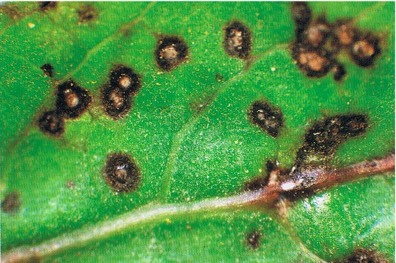PESTS AND DISEASES OF FORESTRY IN NEW ZEALAND
Poplar anthracnose caused by Marssonina species
Scion is the leading provider of forest-related knowledge in New Zealand
Formerly known as the Forest Research Institute, Scion has been a leader in research relating to forest health for over 50 years. The Rotorua-based Crown Research Institute continues to provide science that will protect all forests from damage caused by insect pests, pathogens and weeds. The information presented below arises from these research activities.
Poplar anthracnose caused by Marssonina species.
From Scion publication An Introduction to The Diseases of Forest and Amenity Trees in New Zealand,
Forest Research bulletin 220, G.S. Ridley and M.A. Dick 2001.
Species:
Marssonina brunnea, M. castagnei (Ascomycete anamorph).
Common name:
Poplar anthracnose.
Country of origin:
Northern Hemisphere
Host(s):
Populus alba, P. canescens, P. tremula, P. tremuloides, P. candicans, P. trichocarpa, P. yunnanensis, P. deltoides, and some species hybrids.
Symptoms:
Marssonina brunnea — small black lesions on leaf surface (Fig. 40); when infection is heavy, spots merge to form irregularly shaped necrotic patches; circular lesions with white raised centres on 1- to 2-year-old shoots; dieback of shoots when girdled by lesion; wide host range.
Marssonina castagnei — circular to irregular lesions which expand to form chestnut-brown blotches on upper leaf surfaces; white masses of conidiospores on lesions after moist weather; confined largely to Populus alba and its hybrids.

Fig. 40: A leaf of Populus deltoides x P. nigra hybrid with typical black spots of Marssonina brunnea
Disease development:
Marssonina brunnea — Small lesions are found in spring and these increase in size so that by autumn large blotches have formed. The fungus overwinters in the lesions on twigs and branches of deciduous poplars, and on the leaves of evergreen and semi-evergreen poplars. Conidiospores can also overwinter on dead leaves on the ground. In early spring conidiospores are spread to new leaves by wind-driven rain and water splash. If there is ample moisture available, sporulation is profuse and infection levels increase rapidly.
Marssonina castagnei — Development is similar to that of M. brunnea except that shoots are not attacked.
NZ distribution:
Marssonina brunnea and M. castagnei are found throughout New Zealand.
Economic impact:
Susceptible trees are repeatedly attacked which weakens them and may lead to death (Fig. 41).

Fig. 41: Populus alba defoliated by Marssonina castagnei
Control:
Monthly spraying of benomyi, captafol, dodine, thiophanate, chlorothalonil, or triforine. Breeding and selection for resistance are also in progress.
Note:
Marssonina salicicola causes a leaf spot associated with early defoliation, twig cankers, and dieback of Salix spp. Salix babylonica, S. matsudana, S. matsudana x S. alba, and S. argentinensis are highly susceptibile, S. fragilis cultivars have varying degrees of susceptibility, and S. alba cultivars are highly resistant. Found throughout New Zealand.
References:
Dingley 1969; Gilmour 1966; Spiers 1983a,b, 1989, 1998; Wilkinson 2000.
This information is intended for general interest only. It is not intended to be a substitute for specific specialist advice on any matter and should not be relied on for that purpose. Scion will not be liable for any direct, indirect, incidental, special, consequential or exemplary damages, loss of profits, or any other intangible losses that result from using the information provided on this site.
(Scion is the trading name of the New Zealand Forest Research Institute Limited.)

 Farm Forestry New Zealand
Farm Forestry New Zealand

